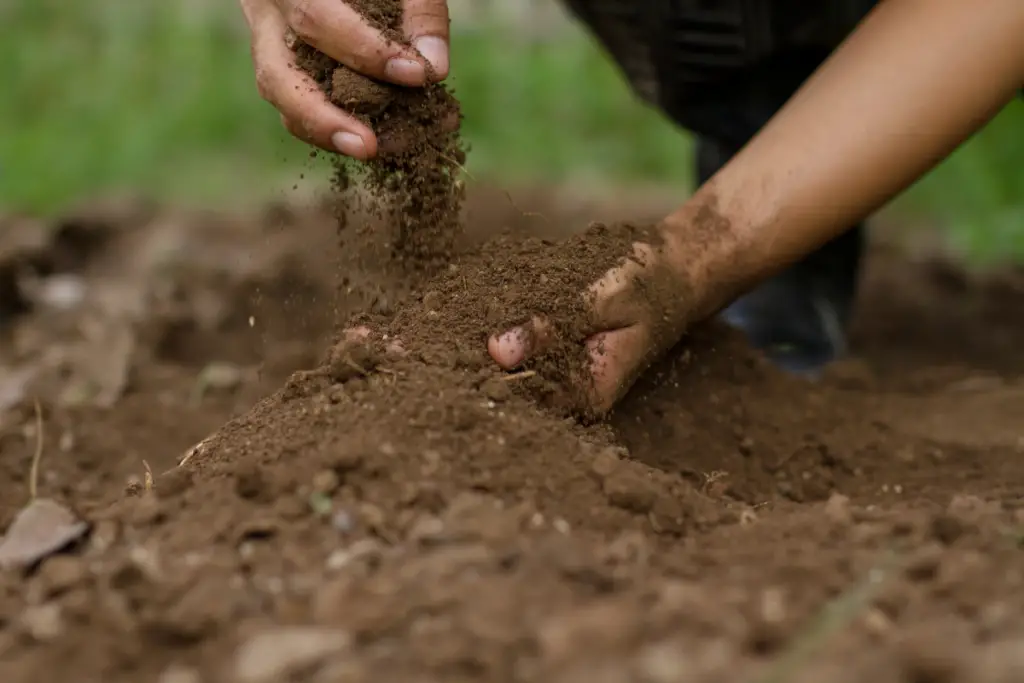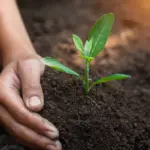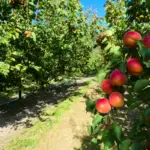Silt soil is a type of soil that contains a high proportion of silt-sized particles, which are larger than clay but smaller than sand.
It is an important type of soil for agriculture and gardening, as it has unique characteristics that can affect plant growth and soil health.
Understanding the characteristics of silt soil is important for gardeners and farmers to optimize their soil management practices.
Silt soil is known for its ability to retain moisture and nutrients, making it ideal for growing crops that require consistent moisture levels.
It also has good drainage properties, which prevent waterlogging and soil erosion. However, silt soil can also be prone to compaction, which can reduce its ability to hold moisture and nutrients.
Therefore, it is important to manage silt soil carefully to maintain its optimal characteristics.
One of the key characteristics of silt soil is its texture. Silt particles are fine and smooth, which gives silt soil a silky texture that is easy to work with.
This texture also allows silt soil to hold onto nutrients and moisture, making it a valuable soil type for growing crops.
However, silt soil can also be prone to erosion, as the fine particles are easily carried away by wind and water.
Therefore, it is important to manage silt soil carefully to prevent erosion and maintain its texture.

Table of Contents
Basic Definition of Silt Soil
Silt soil is a type of soil that is made up of fine mineral particles that are larger than clay but smaller than sand.
It is classified as fine-grained soil, or the fine-grained portion of soil, with a particle size ranging from 0.002 to 0.05 mm in diameter.
Silt soil is non-plastic or very slightly plastic and exhibits little or no strength when air-dried.
Silt soil is formed by the accumulation of sediments that are transported by water, wind, or ice. It is commonly found in river valleys, floodplains, and other areas where water is present.
Silt soil is usually dark in color and has a smooth, silky texture. It is also known for its ability to hold moisture, making it an ideal soil type for growing crops.
One of the defining characteristics of silt soil is its ability to retain nutrients and water.
Silt soil has a high water-holding capacity, which allows it to retain moisture and nutrients for extended periods.
This makes it an ideal soil type for growing crops that require a lot of water, such as rice, wheat, and corn.
Silt soil is also known for its ability to drain well. It has a moderate to high permeability, which means that water can easily pass through it.
This makes it less susceptible to waterlogging and soil erosion, which can be a problem in areas with heavy rainfall.
Physical Characteristics of Silt Soil
Silt soil is a type of soil that is composed of fine mineral particles that are larger than clay and smaller than sand.
It is often found in riverbeds, floodplains, and deltas, as it is easily transported by water.
Here are some of the physical characteristics of silt soil:
Particle Size
Silt soil particles are small, with a diameter ranging from 0.002 to 0.05 mm.
This makes them larger than clay particles but smaller than sand particles.
The small size of silt particles means that they have a large surface area in proportion to their volume, which can affect the soil’s ability to retain water and nutrients.
Color and Texture
Silt soil is typically gray or brown in color, although it can also be yellow or red depending on the mineral content.
The texture of silt soil is smooth and silky, and it feels similar to flour or talcum powder when dry.
When wet, silt soil becomes sticky and dense, making it difficult to work with.
Porosity and Permeability
Silt soil has a moderate to high porosity, meaning that it can hold a significant amount of water.
However, its permeability is low, which means that water does not move through it easily.
This can lead to waterlogging and poor drainage in areas with high silt soil content.
Chemical Properties of Silt Soil
pH Level
The pH level of silt soil can vary, but it is typically neutral to slightly alkaline, with a pH range of 6.0 to 8.0.
This range is suitable for most crops, as it provides a good balance of nutrients and minerals.
However, if the pH level becomes too acidic or too alkaline, it can affect the availability of certain nutrients and reduce crop yields.
Therefore, it is important to monitor the pH level of silt soil regularly and make adjustments as necessary.
Nutrient Content
Silt soil is generally rich in nutrients, making it ideal for plant growth.
It contains a good balance of essential nutrients, including nitrogen, phosphorus, and potassium.
Silt soil also contains micronutrients such as calcium, magnesium, and sulfur, which are important for plant growth and development.
In addition, silt soil has a high water-holding capacity, which allows plants to access moisture and nutrients for longer periods.
This is especially important in areas with low rainfall or during periods of drought.
However, silt soil can also be prone to nutrient leaching, which occurs when water washes away nutrients from the soil.
To prevent this, it is important to use proper fertilization techniques and avoid overwatering.
Silt Soil and Water Retention
Silt soil is a type of soil that contains medium-sized particles, which provide better water retention than sandy soils.
It has moderate water-holding capacity and drainage characteristics. During drought, silty soils can retain moisture for longer periods compared to sandy soils.
Silty soils have more plant-available water capacity than clayey soils.
According to a study published in Soil and Tillage Research, biopolymer treatment can improve water retention characteristics of silt soils and promote vegetation growth.
The Yellow River basin, for example, has severe soil and water loss, and biopolymer treatment may be a promising solution for improving water retention in silt soils [3].
Silty and sandy soils are more prone to water erosion, particularly in areas with high rainfall and where the ground slopes.
Fields that are susceptible to erosion commonly have shallow channels or rills, or sometimes even larger deeper gullies, after heavy rain.
Advantages of Silt Soil
Silt soil has several advantages that make it a desirable soil type for gardening and farming.
Here are some of the advantages of silt soil:
1. Nutrient-rich soil
Silt carries a lot of nutrients and adds organic matter to the soil because it consists of decaying plants, insects, animals dead leaves that fall from trees as well as animal excrements.
This makes silt soil a great choice for growing plants, as it provides them with the necessary nutrients they need to grow and thrive.
2. Retains moisture
Silt soil has the ability to retain moisture for a longer period of time compared to other soil types.
This is because silt soil has smaller particles compared to sand, which allows it to hold water better.
This makes silt soil a great choice for areas that experience dry spells or for plants that require consistent moisture.
3. Good drainage
Silt soil has good drainage due to its small particle size, which allows water to flow through it easily.
This makes it less prone to waterlogging, which can be detrimental to plant growth.
4. Easy to work with
Silt soil is easy to work with because it is soft and pliable.
This makes it easier to till and cultivate, which can save time and effort for farmers and gardeners.
5. Suitable for a variety of plants
Silt soil is suitable for a wide range of plants, including vegetables, fruits, and flowers.
This makes it a versatile soil type that can be used for different types of crops.
Disadvantages of Silt Soil
Silt soil, like any other type of soil, has its disadvantages. It is important to understand these disadvantages to make informed decisions when it comes to planting and cultivating crops.
Drainage Issues
One of the main disadvantages of silt soil is its poor drainage. Silt soil has a tendency to become compacted, which makes it difficult for water to penetrate the soil.
This can lead to waterlogging, which can cause root rot and other problems for plants.
Low Nutrient Retention
Silt soil also has a low nutrient retention capacity. This means that it is not able to hold onto nutrients for very long, which can be a problem for plants that require a lot of nutrients to grow.
As a result, plants grown in silt soil may require more frequent fertilization to maintain their health.
Erosion
Silt soil is also prone to erosion, particularly when it is exposed to heavy rainfall or strong winds.
This can lead to the loss of valuable topsoil, which can make it more difficult to grow crops in the future.
Susceptibility to Compaction
Finally, silt soil is susceptible to compaction, which can make it difficult for plants to establish a healthy root system.
Compaction can be caused by heavy foot traffic, heavy machinery, or even the weight of the soil itself. Once the soil becomes compacted, it can be difficult to reverse the damage.
Suitable Crops for Silt Soil
Silt soil is known to be rich in nutrients and has excellent water retention capabilities, making it ideal for growing a variety of crops.
Here are some of the crops that are suitable for silt soil:
Vegetables
- Green Beans: Green beans can grow well in silt soil due to its high fertility and moisture retention. They require a pH level between 6.0 and 6.8 and adequate fertilization.
- Peas: Peas are another vegetable that can thrive in silt soil. They require a pH level between 6.0 and 7.5 and adequate fertilization.
- Cucumbers: Cucumbers are also suitable for silt soil. They require a pH level between 6.0 and 7.0 and adequate fertilization.
- Potatoes: Potatoes can grow well in silt soil due to its excellent water retention capabilities. They require a pH level between 4.8 and 5.5 and adequate fertilization.
- Squash: Squash can also thrive in silt soil. They require a pH level between 6.0 and 7.5 and adequate fertilization.
- Beets: Beets can grow well in silt soil due to its high fertility and moisture retention. They require a pH level between 6.0 and 7.5 and adequate fertilization.
- Radishes: Radishes are another vegetable that can thrive in silt soil. They require a pH level between 6.0 and 7.0 and adequate fertilization.
- Spinach: Spinach can grow well in silt soil due to its excellent water retention capabilities. They require a pH level between 6.0 and 7.5 and adequate fertilization.
Grains
- Wheat: Wheat can be grown in silt soil, but it requires more fertilization than vegetables. It is important to use a slow-release fertilizer to ensure the nutrients are released over a longer period of time.
- Barley: Barley can also be grown in silt soil. Like wheat, it requires more fertilization than vegetables. It is important to use a slow-release fertilizer to ensure the nutrients are released over a longer period of time.
It is important to note that different crops have different requirements for pH levels and fertilization.
Farmers should conduct soil tests to determine the pH level and nutrient content of their soil to ensure the best possible crop yields.
Improving Silt Soil Quality
Silty soil can be improved to increase its water-holding capacity and nutrient availability.
Here are some ways to improve silt soil quality:
1. Add organic matter
Adding organic matter like compost, manure, or leaf litter can improve the soil structure and increase the nutrient content of silt soil.
Organic matter also helps to retain moisture in the soil. It is recommended to add 2-3 inches of organic matter to the topsoil and mix it well with the silt soil.
2. Use cover crops
Cover crops like legumes, clovers, or grasses can be grown to improve silt soil quality.
Cover crops help to fix nitrogen in the soil, increase organic matter content, and prevent soil erosion.
After the cover crops have grown, they can be tilled into the soil to improve soil quality.
3. Apply fertilizers
Fertilizers can be used to improve the nutrient content of silt soil. However, it is important to apply the right amount of fertilizer to avoid over-fertilization and nutrient runoff.
Soil testing can be done to determine the nutrient deficiencies in the soil and the appropriate amount of fertilizer to apply.
4. Use mulch
Mulching can help to retain moisture in the soil and prevent soil erosion. Organic mulches like straw, leaves, or wood chips can be used to improve silt soil quality.
Mulch should be applied to a depth of 2-3 inches and should not be in direct contact with the plant stems.
Improving silt soil quality can take time, but with the right approach, it is possible to improve soil fertility and plant growth.
By adding organic matter, using cover crops, applying fertilizers, and using mulch, silt soil can be improved to support healthy plant growth.
Conclusion
Silt soil is a type of soil that is made up of rock and mineral particles that are larger than clay but smaller than sand.
It is a solid, dust-like sediment that water, ice, and wind transport and deposit.
Silt soil has a number of characteristics that make it unique. For example, it has a moderate amount of water-holding capacity, which makes it suitable for growing a variety of crops.
Additionally, silt soil is quite fertile, which means that it can support a wide range of plant life.
However, there are also some disadvantages to silt soil. For example, it can be prone to erosion and compaction, which can make it difficult to grow crops or support plant life.
Additionally, silt soil can be quite heavy, which can make it difficult to work with.
- How to Dry Basil Leaves: A Professional Guide
- Is an Avocado a Fruit or Vegetable? Simple Answer and Explanation
- Does Pineapple Have Seeds? Exploring the Anatomy of Pineapples
- Blooming Through Winter: Can I Grow Vegetables Indoors in the Winter?
- What Can You Grow in a Greenhouse All Year Round: A Guide to Year-Round Greenhouse Gardening
- Are Blueberries Blue? Debunking the Myth of Their Color
















